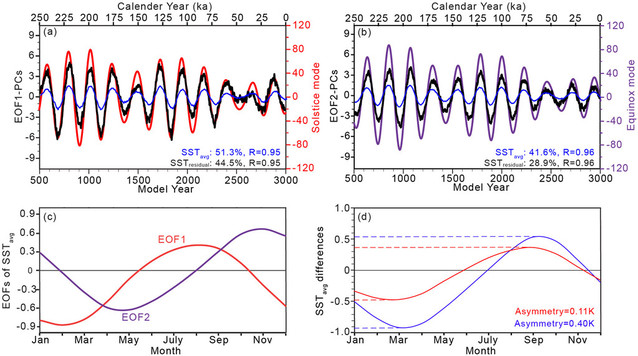Yue Wang a, ZhiMin Jian a, Ping Zhao b, Kang Xu c, Haowen Dang a, ZhongFang Liu a, Dong Xiao b, JunMing Chen b
a State Key Laboratory of Marine Geology, Tongji University, Shanghai, 200092, China
b State Key Laboratory of Severe Weather, Chinese Academy of Meteorological Sciences, Beijing 100081, China
c State Key Laboratory of Tropical Oceanography, South China Sea Institute of Oceanology, Chinese Academy of Sciences, Guangzhou 510301, China
d Chinese Academy of Meteorological Sciences, Beijing 100081, China
Abstract:
Based on a transient simulation of the Community Earth System Model, we identified two anomalous “zonal triple-pole type” annual cycles in the equatorial Pacific sea surface temperature (SST), which were induced by precessional evolution of the summer-minus-winter insolation difference and the autumn-minus-spring insolation difference respectively. For example, due to the increased summer-winter insolation contrast, a zonal positive - negative - positive pattern of equatorial SST anomalies was detected after subtracting basin-scale summer SST warming. The positive SST anomalies were associated with anomalous upward air flows over the western Pacific and eastern Pacific, whereas the negative SST anomalies in the central Pacific were coupled with anomalous downward air flows, oceanic upwelling, and thermocline cooling. These central Pacific anomalies were due to multiple air-sea interactions, particularly zonal advection feedback and Bjerknes feedback. This anomalous annual cycle also included winter equatorial air-sea coupled anomalies with similar spatial patterns but opposite signs. The annual mean equatorial rainfall was significantly increased west of 135°E but decreased between 135°E and 160°W in response to the moderately intensified Walker circulation west of 160°W. The autumn-spring insolation contrast induced similar seasonal reversed anomalies during autumn and spring, but the annual means were only weakly enhanced for the Walker circulation and the rainfall anomalies had smaller magnitudes east of 160°E. These distinct responses of the annual mean climate indicated different seasonal biases in terms of the equatorial SST and associated Walker circulation anomalies due to forcing by the two seasonal insolation contrasts, and these findings had meaningful implications for paleoceanographic studies.

Full article:https://journals.ametsoc.org/doi/pdf/10.1175/JCLI-D-18-0668.1


